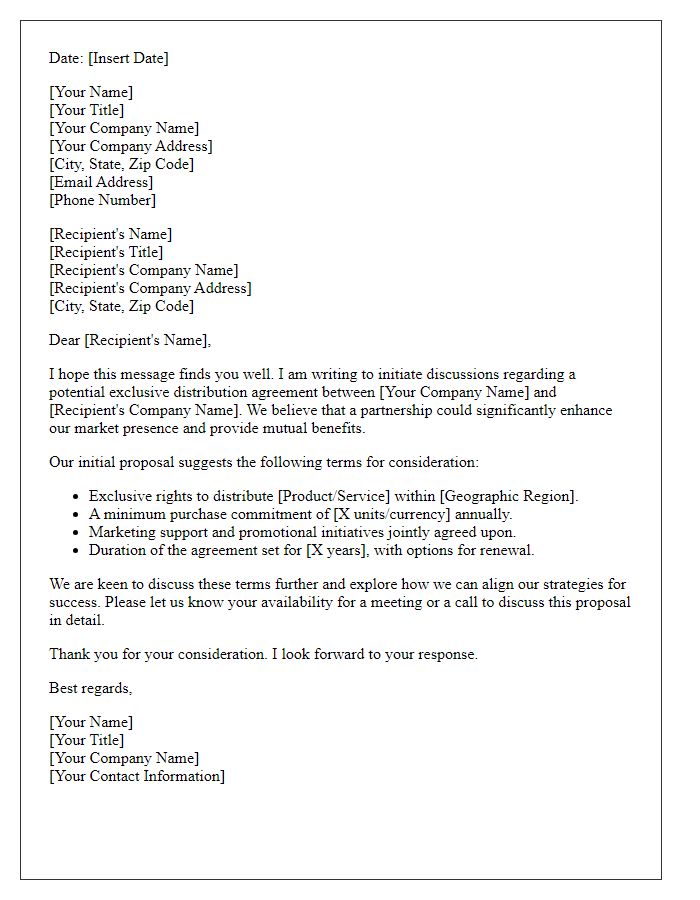Are you considering entering into an exclusive distribution agreement but unsure where to start? Crafting the perfect letter is essential to ensure both parties understand the terms and expectations clearly. This document will not only formalize your partnership but also enhance your business relationships. Let's dive deeper into the key elements you should include to set the stage for a successful collaboration!

Parties Involved
An exclusive distribution agreement involves specific parties, including manufacturers, suppliers, and distributors. For instance, a renowned electronics manufacturer, XYZ Corp., based in Silicon Valley, California, may appoint a local distributor, ABC Distributors, located in Miami, Florida, for exclusive rights to sell its innovative gadgets. Such agreements typically detail the territorial scope, which could cover regions like the Southeastern United States, ensuring that no other distributors can sell the same products in that area. The contract often outlines responsibilities, including minimum order quantities, pricing structures, and marketing commitments, thereby establishing a clear framework for collaboration and mutual benefit.
Scope of Distribution
Exclusive distribution agreements stipulate a defined territory, ensuring the appointed distributor holds sole rights to sell specific products or services in that area. This framework typically includes details regarding product lines, such as high-end electronics or consumer goods, ensuring no other distributors compete within the assigned region, often defined by country or state boundaries like California or France. The scope may also highlight obligations such as minimum sales targets and marketing efforts, fostering a collaborative environment between the manufacturer and distributor. Additionally, it can elaborate on duration, renewal terms, and conditions under which the agreement might be terminated, providing a clear operational blueprint for exclusive rights within the defined market.
Exclusive Rights
An exclusive distribution agreement grants a particular distributor unique rights to sell and distribute a product, ensuring no competitors can market the same product within a defined territory. This agreement typically specifies the product type, such as electronics or cosmetics, the geographic area (like North America or Europe), the duration of exclusivity (often three to five years), and performance metrics required to maintain exclusivity, such as minimum sales targets. Additionally, it outlines the responsibilities of both parties, detailing aspects like marketing efforts and inventory management, and includes provisions for termination, dispute resolution, and potential renewal of rights. This arrangement fosters a strong partnership, encouraging the distributor to invest resources in promoting the product effectively.
Term and Termination
Exclusive distribution agreements play a critical role in defining the relationship between manufacturers and distributors. Such agreements typically include detailed terms outlining the duration of the partnership, often spanning multiple years, providing security for both parties involved in the distribution of products, which may include electronics or consumer goods. Termination clauses are crucial; they specify conditions under which either party may conclude the agreement, including factors like breach of contract, insolvency, or changes in market conditions, ensuring both parties have clear understanding of their rights. These provisions help mitigate potential disputes and allow for a seamless transition if the relationship must be discontinued.
Governing Law and Jurisdiction
An exclusive distribution agreement outlines the legal framework governing the relationship between a supplier and distributor. Governing law generally refers to the body of laws that apply to the agreement, which can vary based on the jurisdiction in which the parties operate. For instance, if the agreement specifies New York law, then any disputes will be resolved under the laws of New York, USA. Jurisdiction determines the authority of a court to hear a case; this could be a specific court in New York or another agreed location, ensuring both parties are aware of the legal venue. Clarity in these terms protects both parties and establishes a clear path for resolution in case of disputes.
Letter Template For Exclusive Distribution Agreement Samples
Letter template of exclusive distribution agreement for technology products

Letter template of exclusive distribution agreement for regional markets












Comments